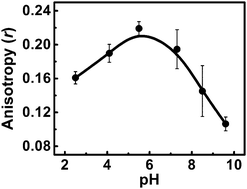Microviscosity, encapsulation, and permeability of 2-ketooctanoic acid vesicle membranes†
Abstract
In the current work, the microviscosity, encapsulation, and permeability of 2-ketooctanoic acid (KOCOOH) vesicle membranes were investigated by steady-state and time-resolved fluorescence techniques, using 1,6-diphenyl-1,3,5-hexatriene (DPH), riboflavin, and calcein as fluorescence probes. Our results show that the microviscosity of KOCOOH membranes is similar to that of common bilayer aggregates, the KOCOOH vesicles have the ability to encapsulate hydrophilic guests, and the KOCOOH membranes are permeable to ions. The permeation of OH− across KOCOOH membranes can be well described using a first-order kinetic model. The KOCOOH vesicles may be a good alternative protocell model that possesses some functional properties necessary for early cell membranes. To the best of our knowledge, this is the first report on the characteristics of vesicle membranes of single-tailed keto-acid amphiphiles.



 Please wait while we load your content...
Please wait while we load your content...